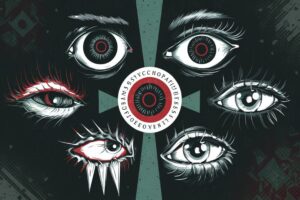How to Identify Psychopathy through 7 Unique Eye Patterns?
Psychopathy, a complex personality disorder characterized by manipulative behavior and a lack of empathy, has long been a subject of fascination and concern in psychology. One intriguing avenue of research in identifying psychopathy lies in the analysis of eye patterns.
The eyes are often referred to as the windows to the soul, and it is believed that certain unique patterns in the gaze of individuals with psychopathic tendencies can offer valuable insights into their inner world.
In this article, we delve into the world of psychopathy and explore how seven distinct eye patterns can be used as potential markers for identifying this elusive personality trait.

Table of Contents
ToggleIntroduction to Psychopathy and its Characteristics
Psychopathy is a personality disorder characterized by a lack of empathy, guilt, and remorse, as well as a tendency to manipulate and exploit others for personal gain. Individuals with psychopathy often exhibit superficial charm, a grandiose sense of self-worth, and a glibness that allows them to easily deceive and manipulate others.
They may also display impulsivity, a lack of long-term goals, and a parasitic lifestyle that involves taking advantage of others for financial or emotional gain.
One of the hallmark characteristics of psychopathy is a lack of empathy, which allows individuals to commit heinous acts without feeling guilt or remorse. This lack of emotional depth makes it difficult for those with psychopathy to form meaningful relationships or understand the pain and suffering they cause to others.
Despite their charming facade, individuals with psychopathy are often described as cold and calculating, with a penchant for exploiting others for personal gain.
While psychopathy is a complex and controversial condition, understanding its characteristics is essential for recognizing and addressing the behaviors associated with this disorder.
Read more about “Is Your Partner Self-Obsessed? Take This Narcissistic test”
Link Between Psychopathy and Physical Cues
Research has shown that individuals with psychopathic traits exhibit differences in brain structure and function compared to non-psychopathic individuals. Additionally, studies have found a link between psychopathy and certain physical cues, such as facial expressions and body language.
For example, individuals with psychopathic traits may have difficulty recognizing and responding to emotional cues in others, leading to a lack of emotional connection and understanding.
These physical cues can play a significant role in how psychopathic individuals interact with and perceive the world around them, ultimately influencing their behavior and interpersonal relationships.
Further research into the connection between psychopathy and physical cues can provide important insights into the underlying mechanisms of this personality disorder and inform interventions and treatments for individuals with psychopathic tendencies.
Read more about “How Chronic Pain impacts Your Interpersonal Connections?”
The Relationship Between Eye Patterns and Psychopathy
Research has shown a potentially intriguing link between eye patterns and psychopathy, a personality disorder characterized by a lack of empathy, remorse, and social responsibility.
Studies have found that individuals with psychopathic traits exhibit distinct eye patterns, such as increased fixations on certain facial features, longer overall gaze durations, and decreased attention to emotional cues.

These abnormal eye patterns may reflect underlying cognitive processes, such as reduced processing of emotional information and increased focus on dominant features.
Understanding the relationship between eye patterns and psychopathy may have important implications for early detection, diagnosis, and intervention strategies for individuals with psychopathic tendencies.
Further research is needed to elucidate the complex interplay between eye patterns and psychopathy and to develop more effective assessment and treatment approaches for this challenging population.
Read more about “From Panic to Peace: 10 Effective Methods to Calm Anxiety”
What are 7-Unique Eye Patterns Associated with Psychopathy?
Psychopathy is characterized by a range of behavioral traits, including superficial charm, manipulativeness, and a lack of empathy. One of the intriguing aspects of psychopathy is that it can be identified not only through behavior but also through certain physical characteristics, specifically eye patterns.
There are seven unique eye patterns associated with psychopathy that have been identified in research studies.

The first eye pattern associated with psychopathy is known as reduced pupil size or constriction. Research has shown that individuals with psychopathic traits have a tendency to exhibit smaller than normal pupil sizes.
This may be linked to the lack of emotional responsiveness typical of psychopaths, as pupils typically dilate in response to emotional stimuli.
Another eye pattern associated with psychopathy is gaze alertness. Psychopaths tend to have a predatory gaze, characterized by intense and unwavering eye contact.
This can be unnerving to others and is believed to be a manifestation of the psychopath’s ability to control and manipulate those around them.
A third eye pattern is known as micro expressions. Psychopaths are adept at masking their true emotions, but research has shown that they may still exhibit micro expressions, or brief flashes of genuine emotion that are difficult to control. These micro expressions can be detected through careful observation of eye movements and expressions.
A fourth eye pattern associated with psychopathy is known as steady eye movements. Psychopaths are known for their calm and controlled demeanor, and this is reflected in their eye movements.
They tend to have smooth and deliberate eye movements, rather than the erratic or jerky movements typical of individuals under stress or emotional duress.
The fifth eye pattern is a lack of visual attention. Psychopaths have been found to exhibit a reduced sensitivity to visual stimuli, meaning they may not pay as much attention to their surroundings or the people around them as non-psychopathic individuals. This lack of visual attention can make them seem detached or disinterested in social interactions.
A sixth eye pattern is known as gaze aversion. While psychopaths are known for their intense gaze, they may also exhibit a tendency to avoid making eye contact in certain situations.
This can be a subtle indicator of their tendency to avoid emotional connections with others, as making eye contact is seen as a way of establishing rapport and empathy.
The seventh and final eye pattern associated with psychopathy is known as rapid blinking.
Read more about “What are the Hidden Symptoms of Generalized Anxiety Disorder?” Psychopaths may exhibit a higher than normal rate of blinking, which could be related to their heightened arousal and decreased emotional responsiveness. This rapid blinking may be a subconscious indicator of the psychopath’s internal emotional state, despite their outward calm demeanor.

The Importance of Eye Patterns in Identifying Psychopathy
The study of eye patterns in identifying psychopathy is of paramount importance in the field of psychology. Psychopathy is a complex personality disorder characterized by a lack of empathy, impulsive behavior, and manipulative tendencies.
Research has shown that individuals with psychopathy exhibit distinct eye patterns, such as reduced eye contact, longer fixations on certain areas, and decreased pupil dilation when viewing emotional stimuli.
These subtle cues can provide valuable insights into the underlying cognitive processes and emotional deficits associated with psychopathy.
By recognizing and analyzing these eye patterns, researchers and clinicians can improve early detection and intervention strategies for individuals with psychopathic traits, ultimately leading to more effective treatment and management of the disorder.
Detailed Description of Each Eye Pattern and its Significance
One of the lesser-known aspects of psychopathy is the unique eye patterns that can be observed in individuals with this disorder. These eye patterns can provide valuable insights into the mind and behavior of a psychopath. Here, we will explore seven unique psychopathy eye patterns and discuss their potential implications.
The first psychopathy eye pattern is known as the “charming gaze.” Individuals with this eye pattern often have a mesmerizing and captivating gaze that can draw others in.

This charm is often used as a tool for manipulation, allowing psychopaths to deceive and manipulate those around them. The charming gaze is often accompanied by a lack of true emotion or sincerity, as psychopaths are skilled at mimicking emotions without truly feeling them.
The second psychopathy eye pattern is the “predatory stare.” This intense and focused gaze is often associated with a psychopath’s lack of empathy and remorse.
The predatory stare can be unsettling and intimidating, as it conveys a sense of threat and danger. Psychopaths may use this stare to assert dominance and control over others, or to instill fear in their victims.
The third psychopathy eye pattern is the “cold and calculating gaze.” Individuals with this eye pattern often have a detached and analytical gaze that can be unsettling to others.
This coldness reflects the psychopath’s lack of empathy and emotional depth, as they approach relationships and interactions with a purely logical and self-serving mindset.
The fourth psychopathy eye pattern is the “haughty and disdainful gaze.” This arrogant and superior gaze reflects the psychopath’s sense of entitlement and grandiosity.
Psychopaths may use this gaze to belittle and demean others, asserting their perceived superiority and dominance. The haughty gaze can be a warning sign of a psychopath’s inflated sense of self-worth and lack of respect for others.
The fifth psychopathy eye pattern is the “manipulative and deceptive gaze.” This subtle and sly gaze reflects the psychopath’s skill at deception and manipulation.
Psychopaths may use this gaze to subtly communicate their intentions and desires, while concealing their true motives and intentions. The manipulative gaze can be a key tool in a psychopath’s arsenal, allowing them to control and manipulate others without their knowledge.
The sixth psychopathy eye pattern is the “vacant and empty gaze.” Individuals with this eye pattern often have a hollow and vacant gaze that can be unsettling to others.
This emptiness reflects the psychopath’s lack of genuine emotion and empathy, as they struggle to connect with others on a deep and meaningful level. The vacant gaze can be a key indicator of a psychopath’s emotional shallowness and detachment from others.
The seventh psychopathy eye pattern is the “intense and piercing gaze.” This focused and penetrating gaze can be unnerving and intimidating to others. Psychopaths may use this gaze to assert their dominance and control over others, or to intimidate and instill fear in their victims.
The intense gaze reflects the psychopath’s underlying aggression and hostility, as they seek to manipulate and control those around them through fear.
Common Traits of Psychopaths
One common trait of psychopaths is their superficial charm and ability to manipulate others to achieve their goals. They are often skilled at using charisma and persuasion to gain trust and manipulate those around them. This charm can be deceiving, as it is often used to mask their true intentions and manipulate others for personal gain.
Another common trait of psychopaths is their lack of empathy and remorse. They are unable to feel compassion or guilt for their actions and may engage in harmful behavior without any sense of remorse. This lack of empathy allows them to exploit and manipulate others without feeling any sense of guilt or responsibility.

Psychopaths are often skilled at mimicking emotions and presenting a facade of normalcy, but underneath this mask lies a complete disregard for the well-being of others.
Psychopathy is a complex and challenging personality disorder characterized by a lack of empathy, manipulativeness, and a disregard for social norms.
Conclusion:
In conclusion, there are seven unique eye patterns associated with psychopathy that have been identified through research studies. These eye patterns provide valuable insights into the underlying psychological traits of individuals with psychopathic tendencies, helping to better understand and identify this complex personality disorder.
Further research into these eye patterns may lead to improved diagnostic tools and interventions for individuals with psychopathic traits.
FREQUENTLY ASKED QUESTIONS
1. Can eye patterns alone determine if someone is a psychopath?
While eye patterns can be indicative of psychopathic traits, they are just one piece of the puzzle. A comprehensive assessment that considers various factors, including behavior, emotions, and interpersonal relationships, is necessary for an accurate diagnosis.
2. Are these eye patterns exclusive to psychopaths?
Not all individuals exhibiting these eye patterns are necessarily psychopaths. These patterns should be viewed in conjunction with other psychopathic traits and behaviors to form a more complete understanding.
3. Can eye patterns change over time in individuals with psychopathic tendencies?
Eye patterns, like other behavioral cues, can be influenced by various factors and may evolve over time. It is essential to consider the context and consistency of these patterns when assessing psychopathic traits.
4. Are there ethical considerations in using eye patterns to identify psychopathy?
Ethical considerations should be taken into account when using any diagnostic tool. It is important to approach the assessment of psychopathy with sensitivity, respect for individual rights, and adherence to professional guidelines.


